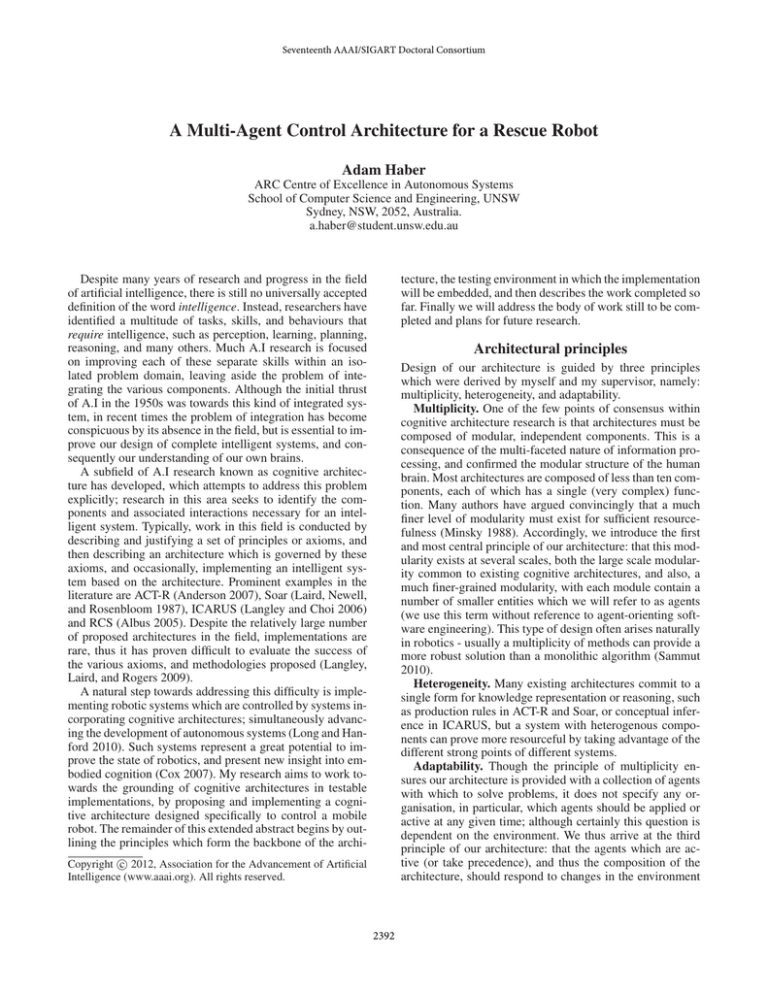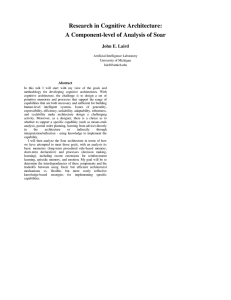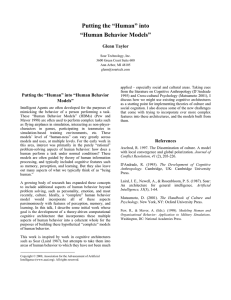
Seventeenth AAAI/SIGART Doctoral Consortium
A Multi-Agent Control Architecture for a Rescue Robot
Adam Haber
ARC Centre of Excellence in Autonomous Systems
School of Computer Science and Engineering, UNSW
Sydney, NSW, 2052, Australia.
a.haber@student.unsw.edu.au
Despite many years of research and progress in the field
of artificial intelligence, there is still no universally accepted
definition of the word intelligence. Instead, researchers have
identified a multitude of tasks, skills, and behaviours that
require intelligence, such as perception, learning, planning,
reasoning, and many others. Much A.I research is focused
on improving each of these separate skills within an isolated problem domain, leaving aside the problem of integrating the various components. Although the initial thrust
of A.I in the 1950s was towards this kind of integrated system, in recent times the problem of integration has become
conspicuous by its absence in the field, but is essential to improve our design of complete intelligent systems, and consequently our understanding of our own brains.
A subfield of A.I research known as cognitive architecture has developed, which attempts to address this problem
explicitly; research in this area seeks to identify the components and associated interactions necessary for an intelligent system. Typically, work in this field is conducted by
describing and justifying a set of principles or axioms, and
then describing an architecture which is governed by these
axioms, and occasionally, implementing an intelligent system based on the architecture. Prominent examples in the
literature are ACT-R (Anderson 2007), Soar (Laird, Newell,
and Rosenbloom 1987), ICARUS (Langley and Choi 2006)
and RCS (Albus 2005). Despite the relatively large number
of proposed architectures in the field, implementations are
rare, thus it has proven difficult to evaluate the success of
the various axioms, and methodologies proposed (Langley,
Laird, and Rogers 2009).
A natural step towards addressing this difficulty is implementing robotic systems which are controlled by systems incorporating cognitive architectures; simultaneously advancing the development of autonomous systems (Long and Hanford 2010). Such systems represent a great potential to improve the state of robotics, and present new insight into embodied cognition (Cox 2007). My research aims to work towards the grounding of cognitive architectures in testable
implementations, by proposing and implementing a cognitive architecture designed specifically to control a mobile
robot. The remainder of this extended abstract begins by outlining the principles which form the backbone of the archi-
tecture, the testing environment in which the implementation
will be embedded, and then describes the work completed so
far. Finally we will address the body of work still to be completed and plans for future research.
Architectural principles
Design of our architecture is guided by three principles
which were derived by myself and my supervisor, namely:
multiplicity, heterogeneity, and adaptability.
Multiplicity. One of the few points of consensus within
cognitive architecture research is that architectures must be
composed of modular, independent components. This is a
consequence of the multi-faceted nature of information processing, and confirmed the modular structure of the human
brain. Most architectures are composed of less than ten components, each of which has a single (very complex) function. Many authors have argued convincingly that a much
finer level of modularity must exist for sufficient resourcefulness (Minsky 1988). Accordingly, we introduce the first
and most central principle of our architecture: that this modularity exists at several scales, both the large scale modularity common to existing cognitive architectures, and also, a
much finer-grained modularity, with each module contain a
number of smaller entities which we will refer to as agents
(we use this term without reference to agent-orienting software engineering). This type of design often arises naturally
in robotics - usually a multiplicity of methods can provide a
more robust solution than a monolithic algorithm (Sammut
2010).
Heterogeneity. Many existing architectures commit to a
single form for knowledge representation or reasoning, such
as production rules in ACT-R and Soar, or conceptual inference in ICARUS, but a system with heterogenous components can prove more resourceful by taking advantage of the
different strong points of different systems.
Adaptability. Though the principle of multiplicity ensures our architecture is provided with a collection of agents
with which to solve problems, it does not specify any organisation, in particular, which agents should be applied or
active at any given time; although certainly this question is
dependent on the environment. We thus arrive at the third
principle of our architecture: that the agents which are active (or take precedence), and thus the composition of the
architecture, should respond to changes in the environment
c 2012, Association for the Advancement of Artificial
Copyright Intelligence (www.aaai.org). All rights reserved.
2392
scribed above. Active perception takes advantage of the capability of a robot both to move and to influence its environment; this module is designed to improve the detection of
victims by improving the information available to the robot.
In this module, the agents will be look-around-by-movingrobot, look-around-by-moving-head, etc. The controller for
this module requires more sophisticated learning and planning algorithms, since only one agent can operate at a time
in contrast to passive perception where all agents can operate in parallel. A learning system based on Inductive Logic
Programming (ILP) to provide adaptability is a current area
of my research.
Future work consists of implementation of the goal-action
module, which will produce the long-term behaviour for the
robot. This module may prove most challenging and innovative, since it is designed to allow the robot to pursue multiple goals concurrently, while switching (productively) between their pursuit; a difficult problem in A.I robotics. The
constituent agents of the module will each pursue their own
goal, i.e observe-victims, do-not-get-stuck, etc. The aim of
the controller for this module is to allow these agents to compete, and dictate which goal should be pursued at which moment, such that the result is productive, and the decisions
made (such as whether to risk harm to the robot to reach a
victim) are appropriate. Testing and evaluation of the architectures performance both in simulation and in reality will
be according to NIST USAR metrics, although the environments will be modified to produce more cognitively challenging situations.
- the activation and deactivation of agents within that architecture should be learned.
Completed Work
A challenging test domain for the proposed system is provided by robotic urban search and rescue (USAR). This
task requires exploration within an unstructured environment, where the system must pursue a multi-objective search
and be faced with unpredictable obstacles. Widely accepted
standards and metrics for USAR have been developed for
the international RoboCup Rescue competition, and we perform our experiments in a test area modelled on its competition arena. Initial experiments were and are being conducted
in a high fidelity 3D physics-based simulation written (by
myself) for this purpose based on the open source jMonkeyEngine3 game engine. No unrealistic information about
the environment is given to the robot, all data comes from a
suite of simulated noisy sensors. Later experiments will be
performed using a real robot.
The complete control architecture has three large modules, each of which is composed of a collection of smaller
agents as described above, and a controller which adaptively
moderates the agents interaction. The functions of the modules are passive perceptual system, an active perceptual , and
a goal-action. The task of the passive perception system is to
search each frame of all available sensor data and determine
whether any victims are in view. In keeping with the multiplicity principle, this is achieved by three separate agents,
each of which act on sensor data independently; they are
warm-skin detector, head-shape detector, and movement detector. Warm-skin detection operates on data from thermal
and colour cameras to detect regions which are both skin
coloured, and within the temperature of human skin. Headshape detection uses information from a 3D depth camera
to search for objects which have an approximately headlike shape(Xia, Chen, and Aggarwal 2010), while movement
detection uses a frame-differencing algorithm acting on the
colour camera data (Bradski 2000).
The controller for this module is provided by a system
that learns which agent is preferable for various perceptual
settings and activates the agents accordingly. The verdicts
from the various agents are then combined, weighted by
their learned confidence values, to produce the systems best
guess at whether there is a victim(s) in shot and its location(s). This system has been implemented using a Naive
Bayes Classifier which receives ground-truth feedback from
the simulation (for the physical robot, a teacher must provide the ground truth) to incrementally learn the agent activation hypothesis, and can successfully identify victims under all the conditions simulated (including in shadow, and
partially obscured). Both the simulation, and the implementation were entirely my own work except where otherwise
cited.
References
Albus, J. 2005. Rcs: A cognitive architecture for intelligent
multi-agent systems. Annual Reviews in Control.
Anderson, J. R. 2007. How can the human mind occur in
the physical universe? New York: Oxford University Press.
Bradski, G. 2000. The opencv library. Dr. Dobb’s Journal
of Software Tools.
Cox, M. 2007. Perpetual self-aware cognitive agents. AI
magazine 28(1):32.
Laird, J. E.; Newell, A.; and Rosenbloom, P. 1987. Soar: An
architecture for general intelligence. Artificial intelligence.
Langley, P., and Choi, D. 2006. A unified cognitive architecture for physical agents. Proceedings of the National
Conference on Artitifical Intelligence 21(2):1469.
Langley, P.; Laird, J. E.; and Rogers, S. 2009. Cognitive architectures: Research issues and challenges. Cognitive Systems Research 10(2):141–160.
Long, L., and Hanford, S. 2010. Cognitive robotics using
vision and mapping systems with soar. SPIE Defence and
Security Conference.
Minsky, M. 1988. The Society of Mind. New York: Simon
and Schuster.
Sammut, C. 2010. Robot soccer. WIREs Cognitive Science
1:824–833.
Xia, L.; Chen, C.; and Aggarwal, J. K. 2010. Human detection using depth information by kinect. Asian Conference
on Computer Vision.
Current and future work
The main thrust of my research, and the area with which
I am currently occupied, is the implementation of higher
cognitive functions; in particular, the last two modules de-
2393





